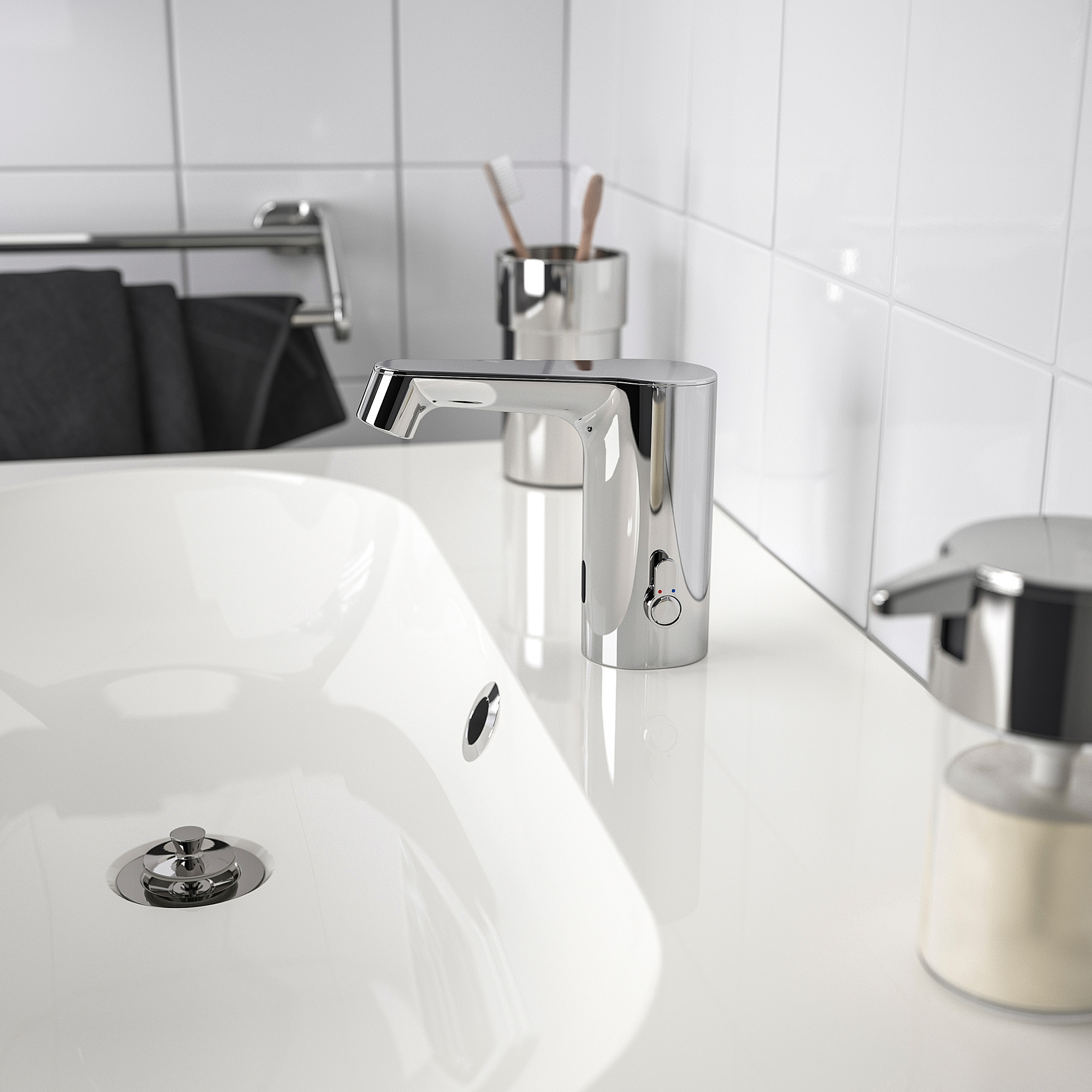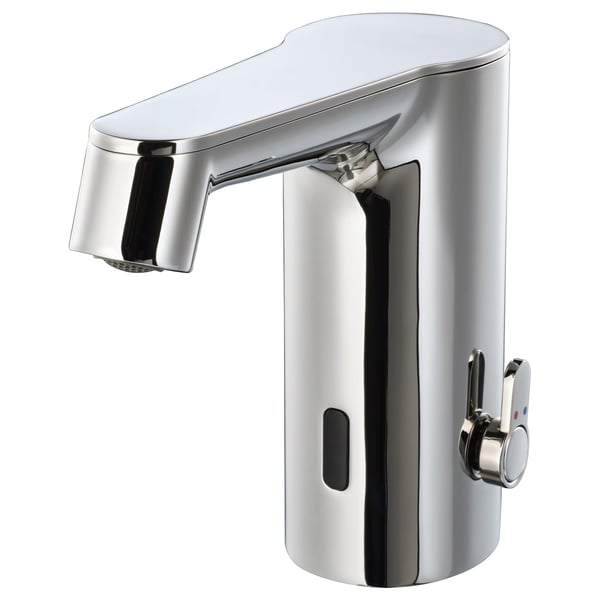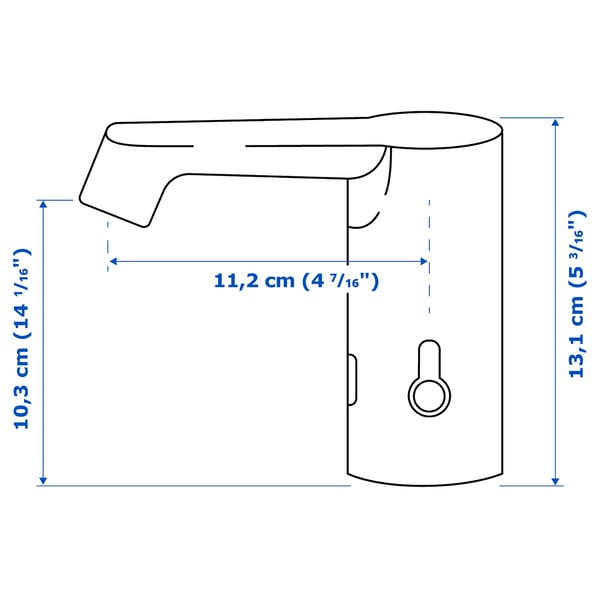So, why conserving water? Because no organism on earth can survive without it, and no new water is created. It's constantly recycled, but our freshwater supply is overused and not evenly distributed. It’s impacted by pollution, contamination and climate change, too. "Those of us who live where you can just turn on your tap may not think about saving water; it's taken for granted," Antony says.
10 year guarantee
Like magic, the water turns on at the slightest hand movement in front of the tap, at a pre-set temperature. A clean and simple design that’s hygienic too, since you don’t need to touch the tap.
Product details
10 year guarantee. Read about the terms in the guarantee brochure.
Built-in pressure compensating aerator keeps the water flow just right and enables water-efficiency.
H Preutz/N Karlsson
Good to know
A tool is included that makes it easy to install the mixer tap in place.
Connection hoses with 3/8" connection included. Connection length: 60 cm.
4 batteries (LR6 AA 1.5V) included.
Max. temperature hot water system 80°C/176°F.
Spare parts are available to prolong the life of your product. For more information, contact IKEA Customer Services at your IKEA store or IKEA.com.
Replacement batteries are available in most stores where alkaline batteries are sold.
If you are uncertain about the installation, contact a professional. The installation shall be made in accordance with valid local building and plumbing regulations.
Fits IKEA wash-basins and standard wash-basins from other manufacturers.
The water turns on automatically when the sensor detects your hands or an object in front of it, and turns off automatically 2 seconds after removing them.
The water temperature is controlled using the lever on the side of the mixer tap.
IKEA of Sweden AB SE-343 81 Älmhult, IKEA.com
Materials and care
Material
- Body:
- Zinc, Chrome-plated
- Inner body:
- Brass
Care
Wipe clean with a soft cloth dampened in water and a mild non-abrasive washing-up detergent or soap, if necessary.
Never use scouring powder, steel wool or a detergent that is calcium-dissolving, sour or contains alcohol or an abrasive.
Safety and compliance
Assembly and documents
Assembly instructions
BROGRUND Wash-basin mixer tap with sensor004.233.54Technical information
BROGRUND
Wash-basin mixer tap with sensor, chrome-plated
Article number004.233.54| Brand Name | IKEA |
| Type of tap | Wash-basin mixer tap with sensor |
| Max. flow rate at 3 bar | 5.7 l/min |
| Annual energy consumption | 415 kWh/p.a. |
| Recommended working pressure | 1 - 5 bar (0.1 - 0.5 MPa) (14.5 - 72.5 psi) |
| Min. working pressure | 1 bar (0,1MPa) (14.5 psi) |
| Max. static pressure | 10 bar (1,0MPa) (145.0 psi) |
| Max. countertop thickness | 50 mm (2") |
| Mounting hole measurement | 34-37 mm (1 3/8-1 7/16") |
| Connection hoses length | 575 mm (22 3/4") |
| Hose connection size | G 3/8" (R10) |
| Recommended cold water temperature | 10-15˚C (50-59˚F) |
| Recommended hot water temperature | 60-65°C (140-150°F) |
| Max. hot water temperature | 80˚C (176˚F) |
| Strainer included | No |
| Amount of batteries | 4 pcs |
| Battery type | AA |
| Third party certified according to local standards by |
Measurements
- Height: 13 cm
Packaging
BROGRUND
Article number004.233.54- Width: 21 cm
- Height: 7 cm
- Length: 35 cm
- Weight: 1.65 kg
- Package(s): 1
Customer reviews
SustainabilityPeople & planet
Energy and resources
Did you know using water more efficiently can reduce your energy bills and help tackle climate change?
Heating hot water accounts for 25% of home energy usage. Using water efficiently reduces energy bills and ultimately reduces carbon emissions. Look for the unified water label and start making a difference. The label has a clear colour coded system to show how much energy and water the product uses. Green rated products use less than those rated Red. Visit www.uwla.eu to find out more.

Water-conscious commitment in bathrooms
Every time you brush your teeth, wash your hands, shave or take a bath, you can help with something essential – saving water. That’s why all our taps have an aerator that saves water and energy while keeping the water stream just right. But that’s just a small part of a bigger effort: conserving more clean water than we use.
Antony Smith, an engineer from England, remembers when he joined IKEA and the small team that develops our taps and showers. "I realized we practice what we preach about sustainability," Antony says. "It's a refreshing experience, but it makes our job really difficult because we genuinely have to deliver on sustainability with each product."
Water is precious, but often taken for granted
Thinking about water at every step
Behind the scenes, we constantly explore new ways to improve water efficiency. That includes providing factory workers and their families with fresh drinking water, ensuring all factory water is cleaned before release, reducing water usage in textile production and using rainwater to flush toilets in stores. And now we are working on new taps using sensors and spray technology – and new water-efficient showers – to save even more. Every water-saving action adds up.
Material
What are zinc and zamak?
Zinc is a metallic element while zamak is a mixture of zinc, aluminium, magnesium and copper. Both are durable materials and easy to cast into different shapes. They are good at conducting heat and electricity. Objects made of zinc or zamak are often given a surface treatment to resemble metals like gold, brass or stainless steel. Both zinc and zamak retain their good properties when they are recycled to become new objects.




